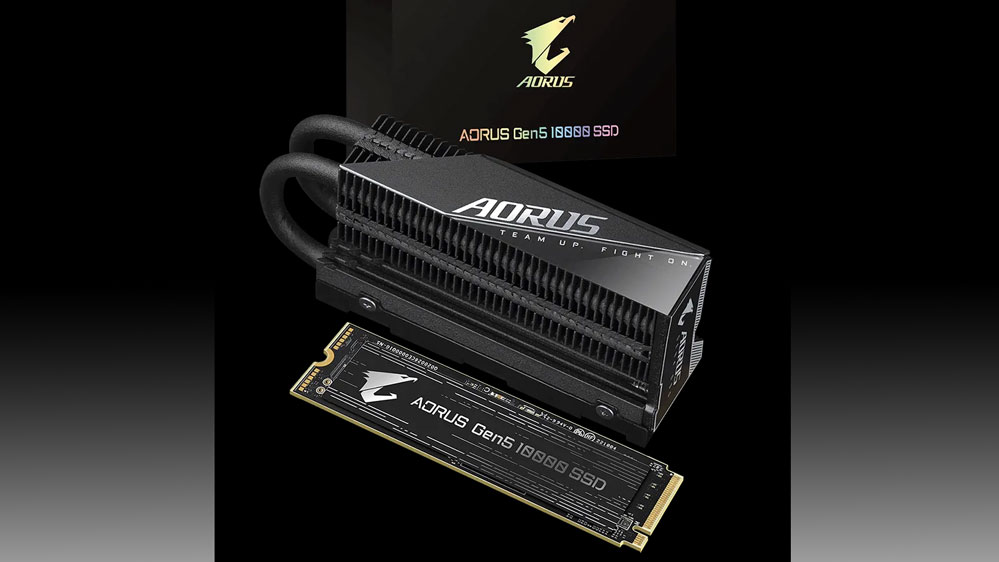
Aorus Gen5 10000 1TB and 2TB SSD Full Specs Revealed
Gigabyte shared full product pages detailing the features and specifications for its speedy Aorus Gen5 10000 1TB and 2TB SSDs. The larger capacity M.2 drive is capable of up to 10,000 MB/s reads, and 9,500 MB/s writes. In addition, this SSD comes with Gigabyte’s optional M.2 Thermal Guard XTREME heatsink with two heat pipes and stacked fins with a nanocarbon coating, promising to keep thermal throttling to a minimum. However, as you will read later, there are a lot of systems in which this heatsink won’t fit.

We reported on the Aorus Gen5 10000 when it was announced in August 2022. Our headline reflected this PCIe 5.0 storage Phison E26 platform tested by Gigabyte R&D with next-gen NAND and other components facilitating a 12,450 MB/s read speed. Unfortunately, shipping SSD won’t have those stellar read/write speeds. However, the 2TB version of the Aorus Gen5 10000 SSD lives up to its name with up to 10,000 MB/s sequential reads. Read below for additional essential tech specs and a comparison between Gigabyte’s 1TB and 2TB models.
|
Aorus Gen5 10000 1TB |
Aorus Gen5 10000 2TB |
|
|---|---|---|
|
Interface |
PCI-Express 5.0 x4, NVMe 2.0 |
PCI-Express 5.0 x4, NVMe 2.0 |
|
Controller |
Phison E26 |
Phison E26 |
|
Form factor |
M.2 2280 (80 x 22 x 2.3mm) |
M.2 2280 (80 x 22 x 2.3mm) |
|
Capacity |
1,000GB |
2,000GB |
|
NAND |
232-layer 3D TLC NAND Flash |
232-layer 3D TLC NAND Flash |
|
External DDR Cache |
LPDDR4 2GB |
LPDDR4 4GB |
|
Sequential Read speed |
Up to 9,500 MB/s |
Up to 10,000 MB/s |
|
Sequential Write speed |
Up to 8,500 MB/s |
Up to 9,500 MB/s |
|
Dimensions with heatsink |
92 x 23.5 x 44.7mm |
92 x 23.5 x 44.7mm |
|
MTBF / Warranty |
1.6M hours / 700TBW |
1.6M hours / 1400TBW |
Above, you can see the performance advantages of the larger capacity drive. Unfortunately, Gigabyte has yet to list a 4TB model. Whichever of the two models you may purchase, they consume <11W when active and <85mW when idle.

Extensive compatibility issues with the Heatpipe Heatsink
Now it is time to ponder the specially designed heatsink, or the ‘M.2 Thermal Guard XTREME’, as Gigabyte / Aorus calls it. The M.2 SSD can run bare or with a motherboard-provided heatsink. Still, Gigabyte recommends using the XTREME heatsink, as it is “the best solution in passive airflow conditions when your personal computer adopts a CPU AIO water cooler.”

The chart above shows the benefits of using the M.2 Thermal Guard XTREME heatsink, which stabilizes temperatures under load at approximately 60 degrees Celsius. However, this heatsink could clash with other components in your system, meaning you can’t use it. Probably most surprising is the heatsink’s distinct lack of compatibility (PDF link) with a wide range of modern Gigabyte / Aorus motherboards.

If you own any Gigabyte / Aorus Mini-ITX motherboard, then you can rule out being able to strap on the M.2 Thermal Guard XTREME. The same is true of a vast swathe of motherboards, as shown here. It might have been easier for Gigabyte to list the compatible boards, and it would have been gracious to include other firms’ products. Having said that, the following motherboards are “highly recommended”: the Z790 Aorus Xtreme, Z790 Aorus Master, Z790 Aero G, X670E Aorus Xtreme, and X670E Aorus Master.
It is great to have the product pages and specs to peruse, but at the time of writing, we don’t have the launch pricing or availability for these 1TB or 2TB drives.

